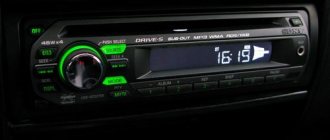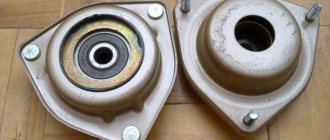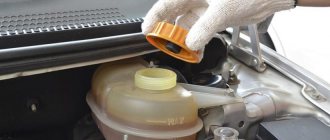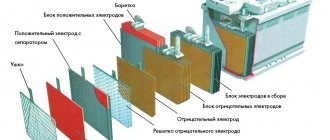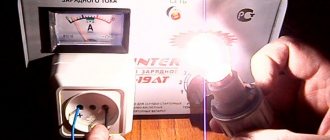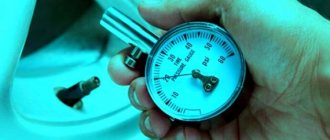The battery is the most important thing in any car. It is this element that provides the starting current to the starter. It is thanks to the battery that the engine starts quickly and without problems. But this doesn't always happen. To avoid difficulty starting, you need to periodically check its charge level. There are several ways to do this.
How to check the charge of a car battery at home? You will find out the answer to this question further in our article.
Built-in indicator
Most imported batteries have a built-in indicator that can be used to check the charge. For the first time such batteries appeared in Japan. Then European manufacturers began to practice a similar trick.
What is its essence? There is a transparent window on the battery cover (a kind of peephole). If you look at it, you can see that it is colored green. But this doesn't always happen. The green tint in the window will only appear if the battery is fully charged. If the window is transparent or white, it means the battery has lost part of its charge. The worst case is a black window. In this case, the battery has run down and needs to be charged urgently.
For your information, this is one of the easiest ways to check the charge of a car battery without a voltmeter and other devices. After all, all you need to do is open the hood and look through that very window. But it is worth noting that not all batteries have such a peephole (especially when it comes to domestic ones). Therefore, to determine the charge level, you need to know other methods.
Load fork
This is perhaps the most professional way to check the condition of the battery. Typically this method is used at service stations. What is its essence? The device is connected to the battery terminals and provides short circuit current.
That is, the load fork simulates the operation of the starter and shows how many volts the battery drops when the driver tries to start the engine. To date, this is the most accurate scheme for checking the condition of the battery. To read the readings correctly, remember that after loading the battery voltage must be at least 10 Volts. If the battery drops to 9 and below, it means it is already weak. Such a battery will discharge quickly in winter.
Can I charge at home?
If there is no garage, it is possible to recharge the battery in the apartment. But it’s better to do this on the balcony. During this process, the electrolyte releases sulfur dioxide and oxygen chloride, which are harmful to humans. Inhaling it may cause dizziness and nausea. Therefore, we charge in the most remote and well-ventilated area. Also monitor the electrolyte condition.
Do not allow the battery to boil. This reduces its resource. On average, a 60-amp passenger battery charges in 7-8 hours. In this case, the charger must be set to the minimum current strength. Stress loads are harmful to the battery. If the battery takes a long time to charge, or one of the cans boils after half an hour, it means it has become unusable.
We use a multimeter
This is an indispensable device that every motorist should have. Allows you not only to check the battery voltage level, but also the resistance of the sensors, the load of the on-board network in real time and many other important parameters. You can purchase this device for 300-700 rubles, which is 2-3 times cheaper than a load fork. This device is very easy to use.
How to check the charge of a car battery with a multimeter? First you need to assemble it. We perform the following actions:
- We connect two wires with positive and negative polarity to the corresponding connectors.
- There will be probes at the ends of the wires. We apply them to the battery terminals.
- First, set the device to voltage measurement mode and set the rotary switch to 20 Volts.
- We connect the multimeter leads to the battery and look at the result. In this case, the car ignition must be turned off.
Preparing the multimeter
We take the device out of the case or cover and inspect the multimeter and wires. When stored for a long time, the plastic of the case and the insulation of the wires tend to degrade. The insulation dries out and the plastic of the casing cracks. Especially if stored carelessly. If the case simply fell apart, we assemble it using standard latches or standard screws. The main thing is that there are no installation elements “outside” - the point is not even that you can get an electric shock - this is unlikely on low-current systems. The fact is that touching can distort the measurement results - the human body has a certain resistance, capacity... The same applies to wires - damage must be insulated. Tape, heat shrink tubing - everything is fine. Checking the food. We switch the selector to resistance measurement mode to a limit of 20 or 200 Ohms - to check the power supply, the specific limit does not matter. The symbol of infinite resistance - one - should appear on the display. We close the probes - naturally, the resistance of the circuit consisting only of probes is zero. That's where zero should be on the scoreboard. If there is any other number on the display, the device is faulty, we take action. If one and zero disappear from the display from time to time, the power supply is most likely low. You need to replace the tester battery with a fresh one.
Electrolyte
There is another way to check the charge of a car battery with your own hands. It is especially relevant on the eve of winter. As is known, with a drop in temperature, the density of the electrolyte decreases. Accordingly, the charge and performance of the battery decreases. How to check the charge of a car battery? For this we need a hydrometer. Below are detailed instructions:
- So, open the hood and, using a negative screwdriver, unscrew the battery “banks” one by one. There are only 6 of them.
- We immerse our hydrometer inside and wait until it is filled with electrolyte.
- Next, we take the device out and look at the readings.
- After a short time, the float will float to the desired level. There will be several divisions on the scale. A figure of 1.23-1.27 grams per cubic centimeter is considered normal. If the electrolyte density is 1.2 grams, then the battery is about a quarter discharged. A deep discharge is indicated by a reading of 1.1 or less grams per cubic centimeter.
It is also worth checking the electrolyte level itself in each of the “cans”. If it is insufficient, it should be renewed. This can be done with distilled water (coolant is also diluted with it).
Do not ignore insufficient electrolyte level in the battery. This can cause frequent loss of charge and shedding of lead plates. As a result, the battery will become unusable, and during any attempts to recharge, the liquid will boil.
How to check battery electrolyte density
To measure the electrolyte density level, you will need a car hydrometer. You need to lower it into the battery filler hole and use a bulb to draw in such an amount of electrolyte so that the float dangles freely. Then look at the level on the hydrometer scale.
The peculiarity of this measurement is that the density of the electrolyte in the battery in winter and summer in some regions will be different depending on the season and the average daily temperature outside. The table presents the data that you should focus on.
Checking the battery with a multimeter
A multimeter gives the most accurate readings. As when working with a load fork, measurements are carried out in two stages: under voltage and without it. Based on the results, the characteristics of the car’s power source are determined, and the car owner receives comprehensive information. The battery test procedure consists of six steps.
- Set the DC voltage measurement mode.
- Set a range greater than the maximum of the vehicle power supply.
- Connect the black clamp to the battery negative.
- Red - to the positive socket.
- Wait for the recorded values.
- Open the assembled circuit.
The process can be viewed here:
Basically, using a multimeter, voltage, current, and resistance are obtained. Checking the battery will require only the first indicator. But, besides this, the device will allow you to determine the capacity. There are three ways to take measurements:
- under load;
- with the vehicle running and additional consumers;
- with the engine turned off.
Similar actions can be carried out with a voltmeter. The devices are simple and inexpensive. But they are not the only option for checking the battery if there is no load plug.
How to find out the battery charge by the density of the working fluid and the “green window”
The battery mixture characterization method only works with serviced power supplies. It is good for owners of cars with this type of battery, since many of them have to deal with electrolyte. Usually in the arsenal of the owner of such a machine there is something to determine the density of the liquid. A hydrometer serves this purpose.
To obtain the value, the device is immersed in the working mixture through the opening of the jar. The sample is collected using a bulb. The density is determined using the scale on the flask. The corresponding mark is indicated by the upper electrolyte level. To check the discharge, you need to calculate how much the result obtained is less than the nominal value. Every 0.01 g/l corresponds to a loss of about five or six percent. For convenience, you can use the table.
| Density at 100% charge, g/cm3 | Discharge density, g/cm3 | |
| 25% | 50% | |
| 1,29 | 1,25 | 1,21 |
| 1,28 | 1,24 | 1,20 |
| 1,26 | 1,22 | 1,18 |
| 1,24 | 1,20 | 1,16 |
| 1,22 | 1,18 | 1,14 |
The different nominal densities are due to different ambient temperatures. The higher the second one, the lower the first one. Let's look at how to test a car battery using a hydrometer. First you need to know the characteristics of the working fluid. The most common value is 1.27 g/cm3. For example, the electrolyte level in the flask is set at 1.23. The difference is 0.04 g/l. 0.04/0.01=4. 4*5=20% About 20 percent - this is how much energy is lost.
The permissible degree of discharge does not exceed 50%. If the battery test shows a value less than that, then you just need to recharge it. But the density changes depending on the temperature during measurement. An appropriate adjustment must be made for this.
- At temperatures from -55 to -45, reduce by 0.05 g/l;
- From -40 °C to -25 °C - by 0.04 g/l;
- From -25 °C to 11 °C - by 0.03 g/l;
- From -10 °C to -4 °C - by 0.02 g/l;
- From 5 °C to 19 °C - by 0.01 g/l;
- From 20 °C to 30 °C does not change
- From 31 °C to 45 °C increase by 0.01 g/l;
- From 46 °C to 60 °C - by 0.02 g/l.
There is an alternative option to check a maintenance-free car power supply. It is also not universal. There are batteries equipped with a built-in indicator, which is called a “green window”. The latter is located on the side or in the center of the device.
This is the most convenient - no additional devices or actions are required. But not everyone will like the price of the issue. A battery without a built-in indicator is almost 30 percent cheaper. It may be more profitable to purchase an inexpensive voltmeter. If the car owner is of this type, then you can assess the condition of the battery by looking under the hood. The color signal means the following:
- green - full charge;
- white - low level of working fluid;
- black - requires recharging.
It looks like this:
How to measure with a multimeter under and without load
Measuring the battery under load is carried out with the engine running. The resulting voltage should be between 13.5 and 14 V. The result above the upper limit can be normalized within ten minutes. This indicator often indicates intensive operation of the generator when the battery is discharged, for example, after idle time at low temperatures.
When the car battery reaches its optimal state, the voltage will drop to the desired level. However, if the first does not happen, then recharging begins. It also threatens the electrolyte boiling away. The consequence is premature wear of the plates and a reduction in battery life.
If the battery test reveals insufficient voltage, it will not charge completely. It is recommended to repeat the measurement by turning off all extraneous electronics or cleaning the terminals of oxide. Now the value should be at least 13.5 V, in extreme cases - 13 V. Figures less than those indicated, if the described conditions are met, indicate a faulty generator.
Using a Multimeter to Test
This device is in demand not only among motorists. It is used in any area related to electrical measurements, including using it to check the performance of the battery. The versatility of such a tool is explained by the fact that it combines a voltmeter, an ohmmeter, and an ammeter. The compact device does not take up much space in the car and is always ready to take the necessary measurements. The battery reserve lasts for a long time, if you remember to turn it off during a break in work.
When choosing an assistant to repair car electrical wiring at home, you need to take into account the following characteristics:
- DC voltage is measured in the range from 0 to 200 mV, 2 V, 20 V, 200 V, 1 thousand V, and alternating voltage is measured from 0 to 200 V, 750 V.
- Resistance testing parameters range from 0 to 200 ohms.
- The DC current run-up in most models is 2, 20, 200 mA.
We recommend: Methods for training and restoring a car battery
These basic parameters can be supplemented with different values and functions depending on the device model.
Battery voltage measurement
This is the most important parameter of the battery’s suitability for operation.
Many drivers test this indicator first. This is done with the engine running. If the device scale displays values from 13.5 to 14 V, then everything is in order with this characteristic. Increased numbers will indicate a low charge level and more energy being supplied from the generator to maintain operating mode. This case often occurs in winter, when a faulty battery runs out of power. There is no need to worry about short-term exceeding the standard data. In a technically sound car, the level stabilizes within 10 minutes. If during the specified period the indicators have not been restored, you need to pay attention to the serviceability of the voltage regulator or the condition of its contacts. If they become oxidized, they need to be cleaned. If there is a decrease in potential below 13 volts, you should think about replacing the battery, as this is an indicator of a faulty element.
If you take measurements with the car not running, you should pay attention to the following nuances:
- A voltage lower than 12 volts will not allow the engine to start, especially in cold weather with thickened oil. The crankshaft will not turn due to insufficient force in such a situation. A normal level is considered to be no weaker than 13 V.
- All measurements should be taken before the start of the movement, and not immediately after its completion.
- A larger charge will keep the battery operating for a longer period. At a lower level, it will sit down faster. Therefore, a new battery or one in close to this condition remains operational longer.
Battery charge and capacity
To check a car battery using this method, you need to analyze the data from a multimeter. Measurements should be taken 5 hours after recharging or disconnecting the battery from the machine. The data in this case will be more accurate. They do not depend on the ambient temperature.
Considering such measurements, the following patterns should be noted:
- A potential difference of 12.8 V indicates a fully charged battery. A large excess hints at serious malfunctions.
- The 75% balance is indicated by the figure 12.6 V.
- The marking 12.2 is taken as half.
- 12 volts will indicate a quarter of the resource.
- Anything less than the last value indicates a minimum reserve.
Information about capacity is no less important than charge. You can test it in the following way:
- The battery must be fully ready for use.
- Apply load to the battery. You can connect several lighting fixtures in series.
- A weak glow at a voltage of 12.4 volts guarantees problems with starting the engine in winter.
- Reducing the data below 12 V requires replacing the battery.
Such a check of the car battery provides an opportunity to avoid problems during start and movement, as well as prolong the operation of the product.
In addition, you can test the capacity by checking the control charge:
- The battery must be completely full.
- Turn it on at deep load according to the passport.
- Connect the device to the circuit.
- Measure the time it takes for the current to decrease by half.
- If it matches what the manufacturer stated, then the battery is working.
We recommend: Determining the release date of the battery by markings
Leakage current measurement
For any car, even a completely new one, this is an inevitable phenomenon. This is explained by the minimal electricity consumption of some consumers even when the engine is turned off. In reference books you can find numbers from 10 to 80 mA depending on the device. If this data is greater, then we can talk about a malfunction of the machine. The ideal value is 60 mA. The lack of daily recharging due to interruptions in operation has a more negative impact on the condition of the equipment.
Before you begin obtaining information, you need to prepare the vehicle for testing:
- Disconnect the interior lighting, radio and other consumers.
- Remove the keys from the ignition.
- Check the information received. Exceeding values of more than 60 mA gives rise to a search for the circuit that receives the maximum power consumption. This can be done by elimination, removing fuse blocks one by one.
This preliminary procedure will provide more accurate information about both the condition of the battery and the power supply circuits.
The procedure for checking leaks is as follows:
- Set the measuring range to 10 A or 20 A.
- Disconnect the minus battery.
- Connect the probe of the device to this place.
- Connect the second one to the removed wire.
- The result will be shown by an indicator board or arrow.
How to properly test a car battery for performance
How to check a car battery?
The voltage of a fully charged car battery must be at least 12.6 volts. If the voltage is less than 12 volts, the degree of charge has dropped by more than 50%, then it urgently needs to be charged!
Deep discharges of the battery should not be allowed; this leads, I repeat once again, to sulfation of the plates. A battery voltage of less than 11.6 V means that it is 100% discharged.
Ways to check the condition of a car battery:
Each of these methods has its own subtleties and nuances. Now let’s take a closer look at how to check your car’s battery for performance with your own hands.
How to check the car battery charge using the indicator
Currently, many batteries are equipped with a built-in indicator indicating its current condition. Japan was the first to use it in battery production.
There is a special window on the battery cover. This is the car battery charge indicator. It is also called a hydrometer. Usually has a green color , indicating that it is completely infected. As the discharge progresses, the color changes. If the color is white or gray, this is a signal that part of the capacity has been lost. This means it needs to be charged. If the color is black , this means that it is completely discharged and needs to be replaced .
The principle of its operation is as follows:
- As the charge level of a car battery increases, the density of the electrolyte increases. Which in turn leads to the fact that the float, in the form of a green ball, rises through the tube and becomes visible in a special window. The float floats up when the battery charge is 66% or higher.
- If the float does not float up, then the condition of the car battery is below normal. As noted, the window will be black, but some have another red ball that will pop up when the battery charge is low.
- If the electrolyte level in the battery is low (partial loss of capacity), the electrolyte itself will be visible through the eye. In such a situation, it is necessary to add distilled water and recharge it.
How to check a battery when buying it in a store or by hand? You can also determine the health of a car battery using the indicator - a fairly simple and easy way .
However, it is worth remembering that the indicator makes it possible to make a preliminary assessment of the degree of charge, but not an accurate one. And you should not fully rely on his testimony; there are more accurate methods. In addition, such a check is not possible with all batteries; some are not equipped with this window. Therefore, it is important to be aware of other methods.
Visual condition check
Here you should immediately understand that you will not be able to obtain any numbers and measurement results, as is the case with the use of testers and multimeters. But we don't need that.
In many ways, you can determine by the external condition of the battery whether it is good or bad, how long it will last and whether it can still perform its functions at all.
I recommend carrying out such procedures before purchasing a new battery, as well as when purchasing a used car.
- Frame. No damage or defects are allowed. Otherwise, if the design is violated, the battery may cause a short circuit, fail at the most inopportune moment and simply not start the engine;
- Dust and dirt. Their presence is not critical, but it is better when the battery remains clean. Keep an eye on this;
- Terminals. It must also be clean. But here it is extremely important to see if there is a white or greenish coating on the terminals. If there is, this is a sign of oxidative processes. The battery is bad;
- Moisture and traces of leaks. If electrolyte is leaking, it is not difficult to notice visually. Traces of moisture also indicate that the battery is gradually reaching its end;
- Fastening and fit. Be sure to check how tightly the terminals are and how tightly the fasteners are tightened, holding the car battery in its rightful place in the engine compartment. If everything is based on snot, it's bad.
If moisture and dirt accumulate on the battery, this will cause accelerated self-discharge. When the terminals are not tight enough, the resistance at the connection areas increases. The starting current will decrease, making it more difficult for the starter to start the engine.
Overheating of the terminals also does not bode well for the car owner. Therefore, such a phenomenon cannot be allowed.
In order for the battery to work well and for a long time, it requires proper care. After all, there is absolutely nothing difficult in periodically removing all dirt and wiping the body with a dry cloth. You can shine a light bulb on yourself to study the condition of the equipment in more detail.
One more point regarding care when traces of electrolyte appear or plaque forms on the terminals. There is no need to throw away the battery. But if leaks are detected, the electrolyte must be properly removed. To do this, make a weak alkaline solution. It's easy to prepare. Take 100 milliliters of water and add a teaspoon of soda. Everything is thoroughly mixed and the surface is wiped with a sponge. Then wipe everything dry with rags.
When oxidizing the terminals, use fine-grained sandpaper. Disconnect the battery first. Next, it would be a good idea to treat the cleaned terminals with technical Vaseline. Or just take some oil from the dipstick and lubricate them. The oil also adequately protects against acidification.
How to check the charge of a car battery with a multimeter
A multimeter is a special device that is used to measure voltage in a network. An important tool that any driver must have. The price of the device is not high. We recommend using those equipped with an electronic scoreboard.
How to properly check the charge of a car battery using a multimeter? To do this, follow these steps:
- Connect the multimeter wires.
- Set the multimeter to voltage measurement mode and set it to 20 Volts.
- Metal wire probes are applied to the battery terminals. (Red probe to the positive terminal, black to the negative terminal).
- See the readings.
Very important! When checking the battery charge with a tester, the car ignition must be turned off!
| Charge level | Multimeter readings |
| Battery is charged | More than 12.7 Volts |
| Half discharged | 12.1 to 12.5 Volts |
| Deep discharge | Less than 11.7 Volts |
Thus, if the voltage on the multimeter is less than 12.7 Volts , then it is not fully charged. If the voltage is less than 11.7 Volts, it is necessary to charge it urgently, because he will not be able to start the car engine.
Unfortunately, checking the charge of a car battery with a multimeter does not give such accurate values as a load plug, but it can still give you some guidance.
Also watch the video on how to check the charge of a car battery with a multimeter:
Checking the battery charge when measuring electrolyte density
This method of checking is quite useful before the onset of winter. A decrease in ambient temperature reduces the density of the electrolyte. Thus the charge also drops. Low density increases the risk that the car engine will not be able to start.
To check the charge of a car battery, you need a special device - a hydrometer. The sequence of actions is as follows:
- 6 caps of battery cans are unscrewed.
- The hydrometer is placed inside the jar. And you need to wait until it is completely filled with electrolyte.
- It is pulled out and over time the float will indicate the current readings.
If the car battery is in good condition, then during the cycle from full discharge to full charge, the range of changes in electrolyte density will be from 0.15-0.16 g/cm3.
Using a car at low negative temperatures with a discharged battery will lead to freezing and disintegration of the lead plates.
In the table you can see at what sub-zero temperature, depending on the density of the electrolyte, ice appears in the battery.
| g/cm3 | 1,10 | 1,11 | 1,12 | 1,13 | 1,14 | 1,15 | 1,16 | 1,17 | 1,18 | 1,19 | 1,20 | 1,21 | 1,22 | 1,23 | 1,24 | 1,25 | 1,28 |
| °C | -8 | -9 | -10 | -12 | -14 | -16 | -18 | -20 | -22 | -25 | -28 | -34 | -40 | -45 | -50 | -54 | -74 |
As you have already noticed, even a fully charged car battery will freeze at a temperature of -74 degrees, and with a capacity of 40% it will freeze at -25 degrees. And with a low charge, up to 10%, it will not be possible to start the engine even in mild frost.
If the loss of current is more than 45-50% in winter, and more than 25% in summer, it must be charged.
What should be the density of the electrolyte ? It is considered normal when the readings are in the range of 1.25 - 12.7 gcm/cubic. If the reading is 12.2 gcm/cubic, then this means that the battery is 25-30% discharged. If less than 1.1. gsm.kub - almost completely discharged.
Additionally, it is worth checking the electrolyte level in each jar; if it is not enough, then you need to top it up. Distilled water is added. Insufficient electrolyte levels are usually the cause of frequent battery discharges.
Checking the electrolyte in the battery
The electrolyte level in the battery plays an important role when operating the device. Its testing can be carried out in different ways depending on the design of a particular battery. Traditionally, motorists assess the electrolyte level visually through the holes under the lids of the battery cans. Some models are equipped with a scale to determine how full the battery is, indicating the maximum and minimum allowed for safe operation of the device. At best, manufacturers make part of the plastic box transparent. To determine the level even more accurately, glass measuring tubes are used, lowered to the bottom of each jar. If you decide to take measurements in this way, do not forget about safety measures, because the electrolyte contains sulfuric acid.
When assessing the condition of the electrolyte in a battery, it is important to measure its density. To study this indicator, you will need a special device, a hydrometer, or densimeter. The complex design consists of a double glass flask, a bulb and a test tube filled with mercury or shot. A hydrometer allows you to establish the exact ratio of the parts of water and sulfuric acid contained in the electrolyte.
The density assessment procedure is carried out no less than 2 hours after the battery is fully charged by taking samples from each jar. The measurement result is considered reliable if a sufficient amount of electrolyte has been collected (before the float rises). The optimal density indicator is 1.27-1.29 g/cm3. If the norm is exceeded, the electrolyte can be diluted with distilled water, and if it is too low, a similar solution with a normal density must be added.
How to check with a charger?
Testing for functionality using a charger will not cause any difficulties for anyone. It is enough to have a special charger for car batteries with a digital display. This method allows you to check the battery charge without a voltmeter.
Important! When checking, do not connect the charger to a power outlet, otherwise the readings will be incorrect.
The sequence of actions is as follows: connect the charger to the terminals and press a special button to test, then read the results.
Help charging your car battery
Method of charging a battery with constant current . The battery is fully charged by connecting the battery to a power source with a voltage of up to 16.2 V. Charging using this method in one hour will reach 1/20 Average, in 10 hours – 1/10 Average. Ср – nominal battery volume.
Advantages of this method:
- Possibility of fully charging the car battery;
- The lower the current, the more complete the charge .
It is necessary to understand that there is no need to reduce the current to a minimum, the charging time will be too long. A high current will cause the car battery to “boil”, as a result it will not be able to fully charge.
Disadvantages of the method:
- Strong gas emission;
- It is necessary to regularly stabilize the current strength.
Constant voltage charging method. Using this method, you can quickly recharge the battery to 90-96% of its volume. But there is also a minus - the car battery gets very hot. The charging current can be high as the voltage increases, but it can also approach zero. The source voltage during charging is in the range of 14.6-15 V.
Worth remembering. Charging the battery should be done in a ventilated area. Charging must be carried out using direct current only.
